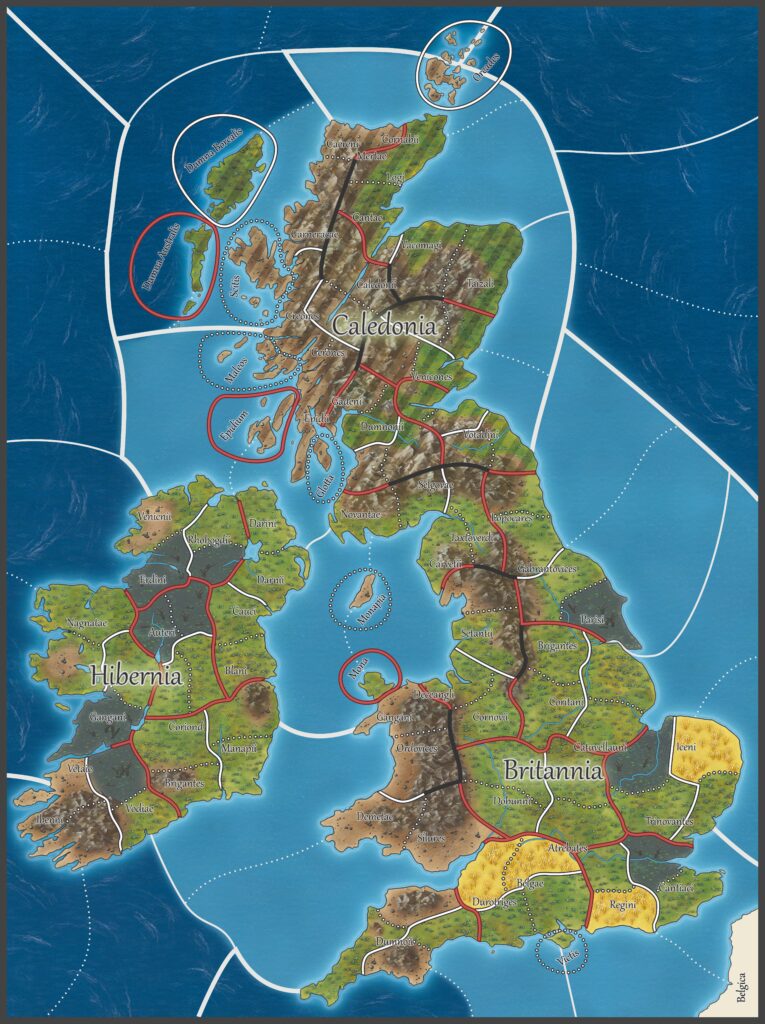
The first map I started with was a map of the British Isles after the Roman legions left. At the time I had returned to board games after ten years and knew nothing about Britannia and Pendragon board games, otherwise I might have saved myself a few tens of thousands of hours of time. The idea was simple, to make a better Game of Thrones with elements of Agricola and a more realistic setting and gameplay overall. The British Isles was therefore the first choice. In addition to 410 AD, there are also 43 AD, 793 AD, 1066 AD and others. However, the 5th century made the most sense to me. The map does answer the more general question of the geopolitics of the British Isles before unification. This was also the first time I saw the game make sense in any number of players. And I’ve definitely relegated the possibility of historical alignment beyond the starting bonuses as something secondary. That is, skirmish over historical simulation. The thing is, the simulation rules out the free skirmish. Whereas a game that has skirmish in the first place can also add a historical setting at any time.
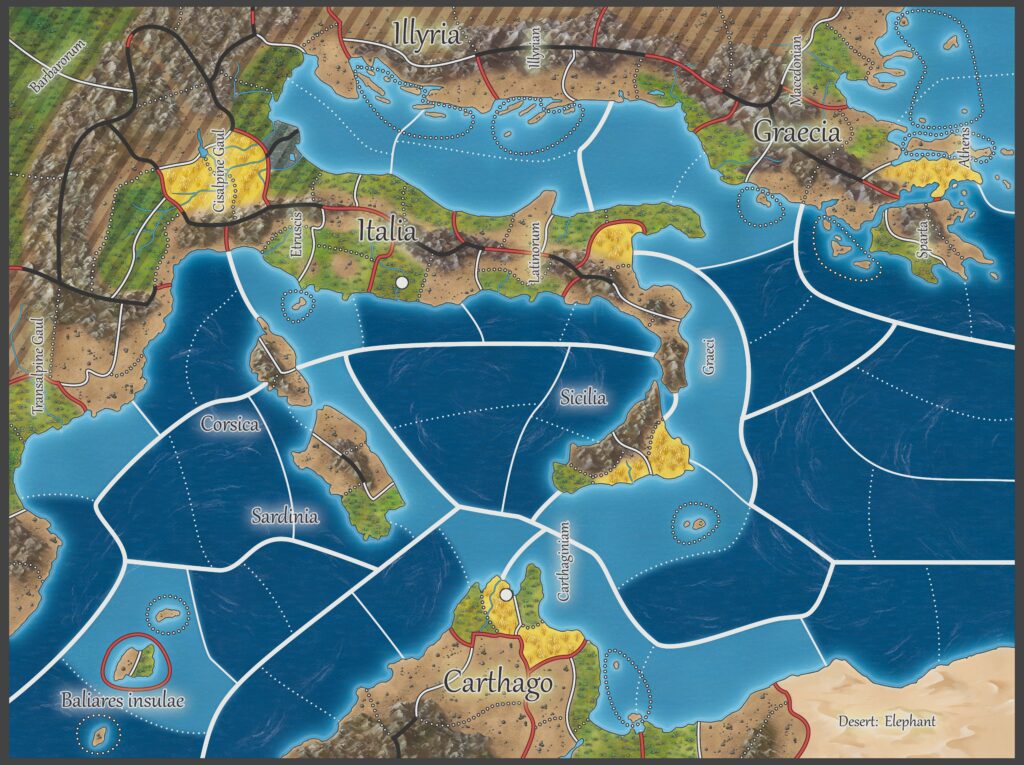
xxThe second map is the Mediterranean before the rise of Rome. As with any map, the period in which agriculture was still a crucial element of power played a role in the selection. Then there was the territory and the time when power was fragmented. Then the skirmish makes sense. The idea is always the same: to prove your mettle over five years and somehow achieve victory in such a situation. And that way is different every time. Depending on the map, the mode, the number of players, but mostly on how the others play. In this map, the sea plays an absolutely crucial role. Those who control it can do a lot in the long run. Rome is in the middle and, as it has been several times, this position means a theoretical advantage and disadvantage at the same time. In addition, two asymmetric starting positions (the city of Rome and the port of Carthage) are added to the map. The cut of the map is chosen so that the capacity of the fields corresponds to the balance of power at this time. However, this means that the north is not orthogonally placed. Alternative years – 476 AD and 1000 AD.
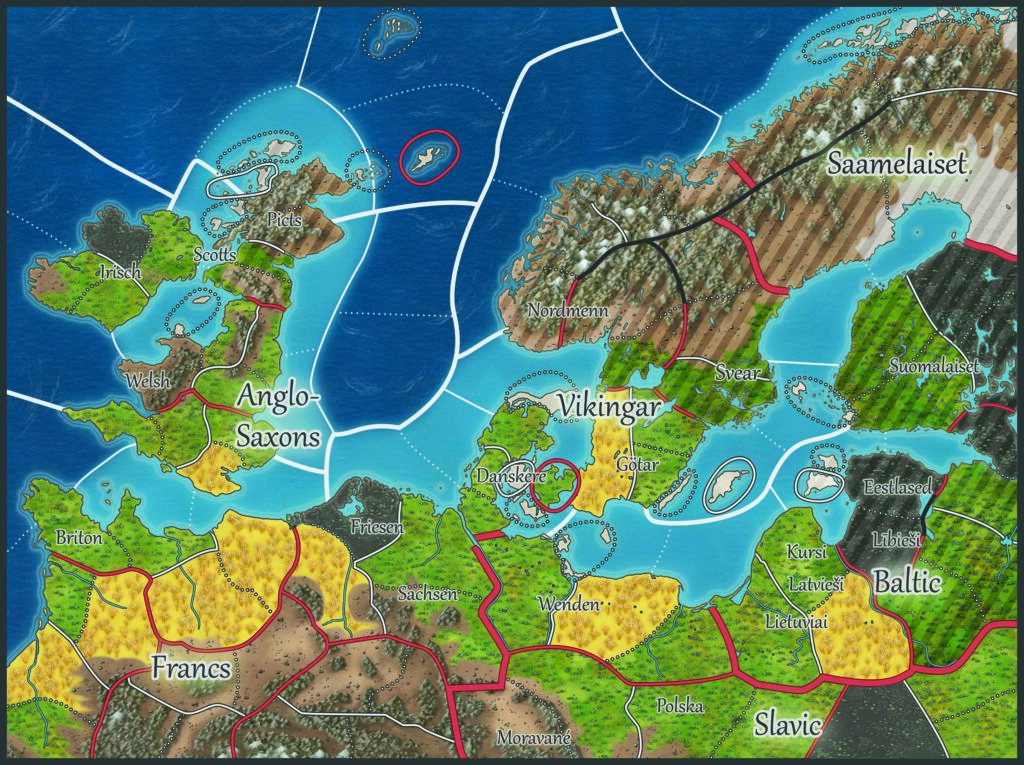
The third map was made shortly before the first Spiel Essen (2019), which I participated in. After about half a year of development. This map also emphasizes the sea, but adds one more element – an aggressive player. Players based in the north have a natural tendency to focus on the sea. Starting in yellow mode, when the starting bonuses are active, the characteristics typical of Vikings are added. This player simply has to be aggressive, playing for time. His territory is poorer and the moment he can consolidate continental Europe (That is practically before he builds cities and buys stronger units), he starts playing second fiddle. So naturally he’ll jump into trade, mobile ship attacks and looting. Yet this entirely new dynamic fits the reality and geopolitics of the place and time. The year 800 AD is also clear, yet you would still offer 476 AD and 1000 AD.
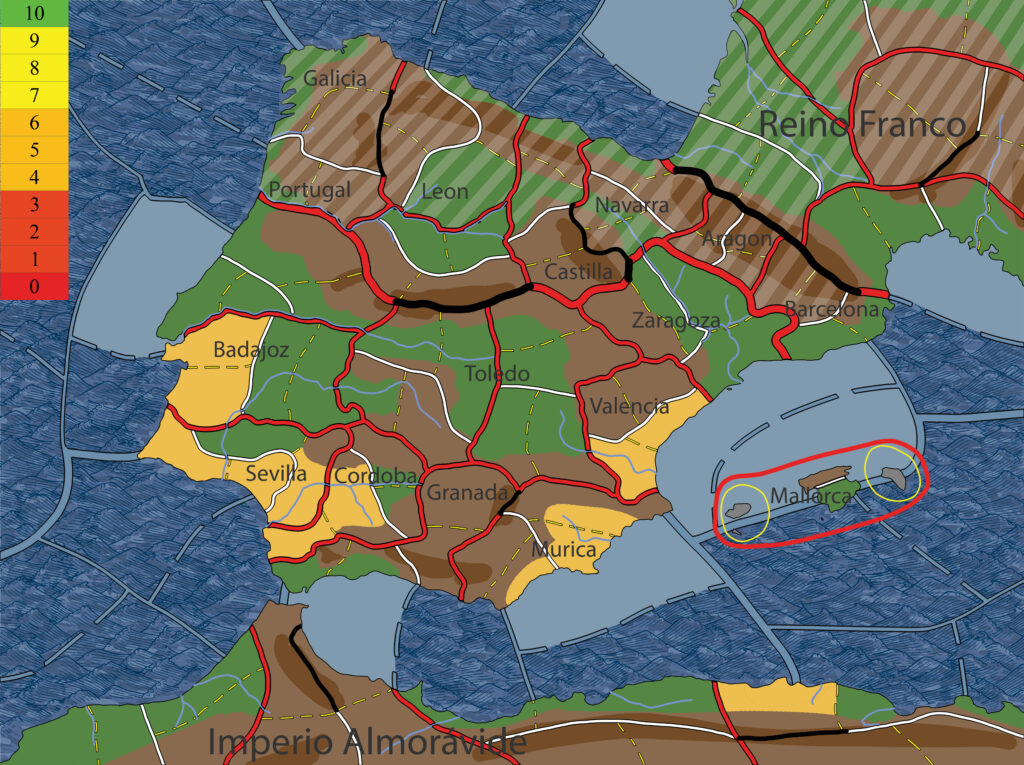
After less than a year of development, it was clear that the game would have at least two parts, and to justify the beautiful wooden components, a fourth map had to be added. This was immediately used for the subsequent beta test in the Czech Republic. At that time I was choosing between Japan and the Iberian Peninsula. The European theme and the fascinating story of the disintegration of Muslim rule and the world famous Reconquista, which however lasted several centuries, offers one of the best battlefields to explore the context. Moreover, there were many separate factions. The map is very continental and presents a very different gameplay thanks to the limited bottlenecks on the main battlefield. The rich Muslim south, the mountainous Christian north, the sea-separated Berber Empire with its cavalry, and the tip of the Frankish Empire as a defensive player make for an interesting starting point. Another interesting feature is the dynamic faction of Vikings who have literally had to earn their place (historically their era was just ending, but they were still able to sack several of the local cities). But then came Covid. I immediately converted the game to TableTop Simulator and Betatest was practically running there. After the cancellation of Spiel Essen 2020 and a very weak Spiel digital, development then stopped for practically a year. Alternative years here would be 218 AD, 476 AD, 650 AD and 711 AD.
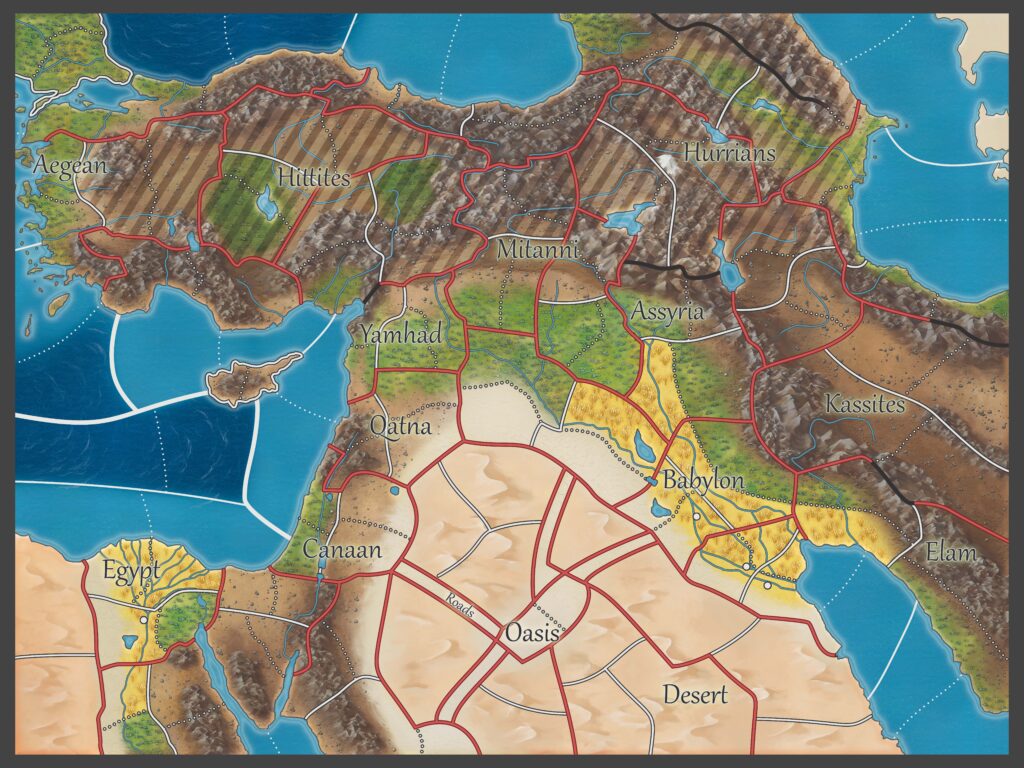
After Spiel Essen 2021, I decided to do a Kickstarter right after Spiel Essen 2022. For that one, I had to prepare part III and it needed two maps. I had them in my head for longer, but I didn’t start development until 2022. The first one was Orient. It tells so many interesting stories that it’s no wonder it’s called the cradle of modern civilization. I chose one of the older ones. The period before the rise of the Mitanni Empire. Why has this region been transformed so many times? How did natural conditions affect it? What about the first cities? Why was cavalry so important here? And are you more attracted here by the collapse of Alexander’s empire, the rise of Islam, the Crusader states or the invasion of the Mongols? Or something else? This is an inexhaustible area of conflict. And my game allows you to try it all out and still have fun with your friends.
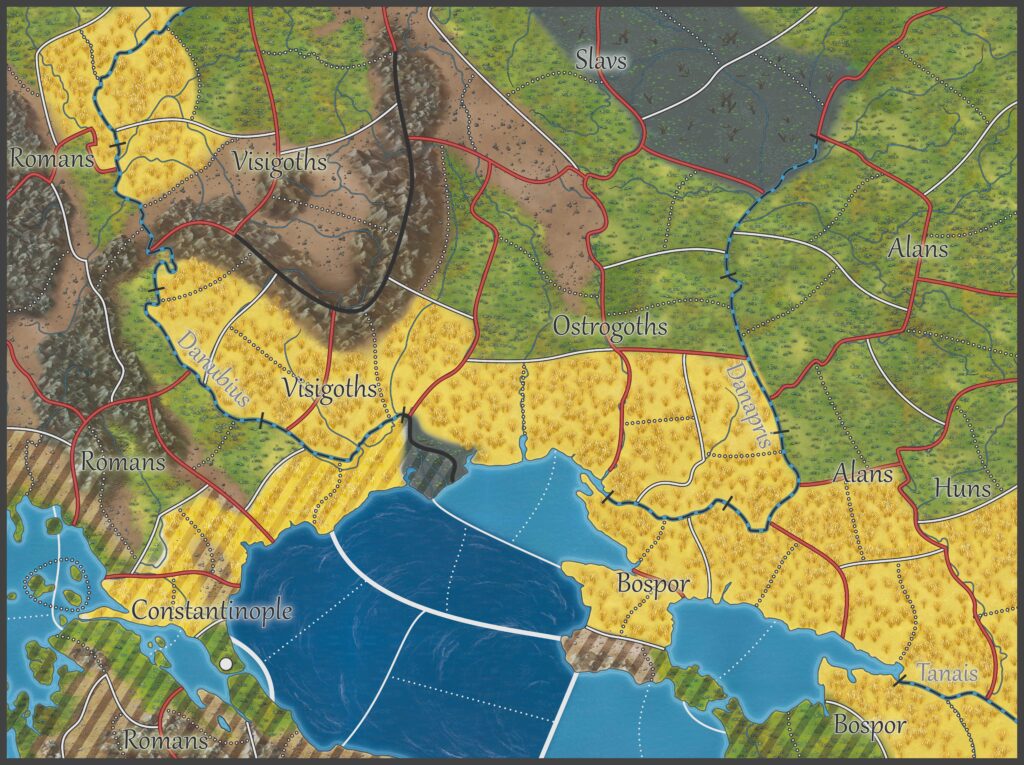
The last map was my biggest dream. The story of the Hun invasion of Europe and the final nail in the coffin of the West Roman Empire began quietly in 373. The steppe region of the southern Ukraine could hardly be dominated by someone like Rome. The arrival of invaders actually happened several times here (after the Huns it was the Avars, Bulgars, Hungarians and then the Mongols). The area has not been spared from conflict even in the present day. My decision to postpone the campaign after the birth of my daughter was finally worth it. For Essen, however, I finally decided to invest in graphics and so, in addition to the artwork, new visuals were created for the last two maps. The new gameplay elements here are the Danube, Dnieper and Don rivers. All of these rivers are difficult to cross (if they freeze in winter; if there are boats; or if they can be crossed upstream). However, the alternative routes are very, very dangerous for cavalry. Rome is already in decline and is actually on the defensive. The Huns, on the other hand, are a snowball being held back only by the rivers. The players in between may try to ally with one side and thus gain victory for themselves in the end.

